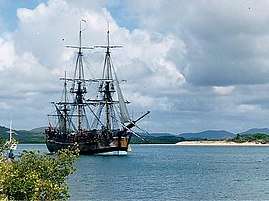Palm Island, Queensland
Palm Island is a locality consisting of an island group of 16 islands, split between the Shire of Hinchinbrook and the Aboriginal Shire of Palm Island, in Queensland, Australia.[4][5][6][7] The locality consists of the Palm Island group, also known as the Greater Palm group, which was originally named the Palm Isles.
| Palm Island Queensland | |
|---|---|
Palm Island, North Queensland | |
 Palm Island | |
| Coordinates | 18.7345°S 146.5794°E |
| Population | 2,455 (2016 census)(Great Palm)[1][2] |
| Postcode(s) | 4816 |
| Time zone | UTC+10 (UTC) |
| Location |
|
| LGA(s) | |
| State electorate(s) | Townsville |
| Federal Division(s) | Herbert |
Great Palm Island is the largest island in the group, and is most often referred to as just "Palm Island". An Aboriginal community is located on this island, which is also called by the Aboriginal name "Bwgcolman". The term "Palm Island" is sometimes used to refer to the island group, sometimes the Aboriginal Shire, and sometimes Great Palm Island, but as most of the other islands are uninhabited, the majority of sources are actually referring to Great Palm only, sometimes along with governance issues relating to the Shire Council.
There are 16 islands in the group. Only Great Palm has a significant population of permanent residents; the rest, apart from Orpheus Island, which has a tourist resort and research facility, are uninhabited.
Geography and governance
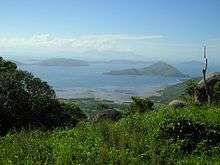
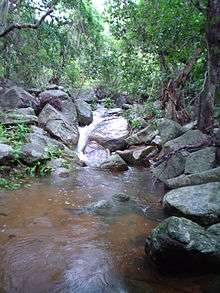
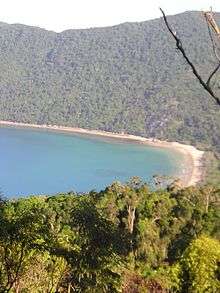
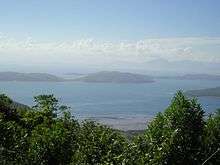
There are 16 islands that make up the Greater Palm group;[8][9] of the 12 named islands, the two most northerly ones (Pelorus and Orpheus) are in the Shire of Hinchinbrook, and the other ten are in the Aboriginal Shire of Palm Island.
The islands listed from north to south, are:[10][11][12]
- Pelorus Island (North Palm Island, Yanooa, Guyroogarrie) – uninhabited and privately owned
- Orpheus Island (Goolboddi – contains national park, research facility and tourist resort, privately owned)
- Albino Rock is part of Orpheus Island National Park.
- Curacoa Island (Noogoo)
- Fantome Island (Eumilli)
- Great Palm Island (Bwgcolman)
- Esk Island (Soopun)
- Falcon Island (Carbooroo)
- Eclipse Island (Garoogubbee)
- Brisk Island (Culgarul)
- Barber Island (Boodthean)
- Fly Island
- Havannah Island
The group was originally named the "Palm Isles". The majority of the islands are micro-islands; the most notable are Great Palm Island (the largest and most populated), Fantome Island, and Orpheus Island. Neighbouring islands outside the Palm group include Rattlesnake Island, which is used for Air Force bombing practice, and Magnetic Island, an island suburb of Townsville. The nearest island to the group is Pandora Reef.[13]
Other names for the island group are the Palm Island group[14] and the Greater Palm group.[15]
The ocean surrounding the islands is part of the Great Barrier Reef Marine Park, where extraction and fishing are regulated.[16]
Local government of the islands is split between the Shire of Hinchinbrook and the Aboriginal Shire of Palm Island.
Palm Island falls in the federal Division of Herbert and the Electoral district of Townsville.
In Table 1 are the ten islands of the group in the jurisdiction of the Palm Island Aboriginal Shire Council.[13][17] The remaining rocks owned by the Commonwealth are in the jurisdiction of the GBRMPA.[13] Table 2 lists additional micro-islands.[13]
| Island name | Aboriginal name | Group size | Brushfire risk | GBRMPA reef designation |
|---|---|---|---|---|
| Curra-cao or Curacoa Island | Noogoo or Inoogoo | major | medium | 18-052 |
| Fantome Island | Eumilli | major | medium | 18-053 |
| Great Palm Island or Palm Island | Bwgcolman | major | high | 18-054 |
| Havannah Island | major | medium | 18-065 | |
| Brisk Island | Culgarool | micro-island | medium | shared with Falcon Island |
| Eclipse Island | Garoogubbee | micro-island | not rated | 18-058 |
| Esk Island | Soopun | micro-island | not rated | 18-059 |
| Barber Island | Boodthean | micro-island | not rated | 18-061 |
| Falcon Island | Carbooroo | micro-island | not rated | 18-062 |
| Fly Island | micro-island | not rated | 18-064 |
| Island name | GBRMPA reef designation |
|---|---|
| Paluma Rock | 18-056 |
| Albino Rock (AKA White Rock) | 18-057 |
| Dido Rock | 18-060 |
| Chilcott Rocks | 18-063 |
| Hayman Rock.[22] | <none> |
Climate
Lying in the tropical zone, the islands' climate is tropical and the area is vulnerable to cyclones.
History
Pre-contact
In Manbarra beliefs the Palm Island group were formed in the Dreamtime from the broken up fragments of an ancestral spirit, Rainbow Serpent.[23]
Manbarra (also known as Wulgurukaba) is a language of the Palm Island region, which lies within the local government boundaries of the Palm Island Aboriginal Shire Council.[24]
The islands in the area were named the "Palm Isles" by explorer James Cook in 1770 as he sailed up the eastern coast of Australia on his first voyage.[25] It is estimated that the population of the island at the time of Cook's visit was about 200 Manbarra people.[26][27] Cook sent some of his men to Palm Island and "they returned on board having met with nothing worth observing".[23]
In 1819, Captain Phillip Parker King landed on one of the islands and recorded seeing recently occupied circular huts, and canoes nearby their landing place.[8]
(Great) Palm Island history
Great Palm Island has always been the most populated island. It is estimated that the population of the island at the time of Cook's 1770 visit was about 200 people. From the 1850s, locals were enticed away to join bêche-de-mer and pearling enterprises with Europeans and Japanese, and By the end of the 19th century the population had been reduced to about 50.[26][27]
In 1914, the Palm Island Aboriginal Settlement was created by the Queensland Government, and relocated people from 1918 all over Queensland, starting with Hull River Mission residents after the mission was destroyed by a cyclone.[8] People from up to 57 language groups were moved there. In the first two decades of its existence, the number of residents rose from 200 to 1,630.[28][29][30] It was regarded as a penal settlement, with people being sent there for perceived wrongdoing, and soon it became the largest government Aboriginal reserve in Queensland.[16][31]
The women’s dormitory closed in 1967 and was demolished in 1969. The children’s dormitories were officially closed on 5 December 1975.[8]
1999: Compensation by Queensland Government for underpaid wages
In 1999 the Queensland Government apologised and gave A$7,000 compensation each to former Palm Islander employees in recompense for underpaid wages between 1975 and 1986.[32] The payment was ordered by the Human Rights and Equal Opportunity Commission in a case first brought to the Commission by seven Palm Islanders in 1986.[33]
2004: Death in custody and consequences
On 19 November 2004, Palm Island resident Mulrunji (known as Cameron Doomadgee while alive), aged 36 or 37,[8] died in a police cell on Palm Island, one hour after being picked up for allegedly causing a public nuisance.[34] After the post-mortem report said that the cause of death was severe internal injuries, riots occurred, and as a result, a number of people were charged with offences.[8]
Two coronial inquests were held, a police officer was tried for manslaughter, but acquitted on 20 June 2007. The Crime and Misconduct Commission examined police relations in Queensland and as part of this, conducted an inquiry into police handling of the Mulrunji investigation. In 2010 it reported that more work was needed on police relations, while noting that some improvement had occurred, recommending 51 specific actions.[8]
The police raids and behaviour following the riot were found in December 2016 to have breached the Racial Discrimination Act 1975,[35] with a record class action settlement of A$30 million awarded to victims in May 2018.[36] The raids were found by the court to be "racist" and "unnecessary, disproportionate" with police having "acted in these ways because they were dealing with an Aboriginal community".[35]
Fantome Island medical facilities (1926–1973)
In 1926 a lock hospital was built on Fantome Island; Aboriginal people were sent there mainly for treatment of sexually transmitted diseases. In 1937 Fantome Island became a medical clearing station, where Aboriginal people sent to Palm Island were examined and treated if necessary.[8] A leprosarium was established on Fantome in 1939.
The hospital was closed in 1945, and the leprosarium in 1973, when the inhabitants were moved to (Great) Palm Island.[27]
2004: Legal action relating to pearl farming
Zen Pearls Pty Ltd and Indian Pacific Pearls Pty Ltd (both controlled by Michael Crimp) established pearl farms in 1998 with the permission of the Great Barrier Reef Marine Park Authority[37] (which controls the sea waters around the islands), despite the opposition of, at least some, of the people of Palm Island.[38] On 24 September 1998 the Manbarra elders passed a resolution opposing the farms on the basis of;
"the historical and cultural significance of the Juno Bay site for both the Manbarra and Bwgcolman Peoples, the sense of trespass on traditional ownership rights, concerns that the cultural connection to the area would slip away and a strong feeling that the provision of a small number of employment opportunities offered by the pearling operations would not adequately compensate the damage to cultural values."[39]
Subsequently, the Park Authority refused to extend the pearl farming permits and Crimp took action before the Administrative Appeals Tribunal to have this decision reversed. On 15 March 2004 the Tribunal agreed that the permits should be terminated but allowed the existing pearling operations to continue to 1 December 2005.[40] This decision was substantially upheld by the Federal Court on 21 October 2004.[41]
References
Citations
- Australian Bureau of Statistics (27 June 2017). "Palm Island (UCL)". 2016 Census QuickStats. Retrieved 9 February 2018.


- Australian Bureau of Statistics (27 June 2017). "Palm Island (SSC)". 2016 Census QuickStats. Retrieved 20 October 2018.

- "Airport PALM ISLAND". Archived from the original on 14 July 2006. Retrieved 5 February 2007.
- "Palm Island - locality in Shire of Hinchinbrook (entry 45505)". Queensland Place Names. Queensland Government. Retrieved 4 November 2019.
- "Palm Island - locality in Palm Island Aboriginal Shire (entry 45506)". Queensland Place Names. Queensland Government. Retrieved 5 November 2019.
- "About the profile areas - Hinchinbrook (S)". .idcommunity (Far North Queensland Regional Organisation of Councils). 11 April 2017. Retrieved 4 March 2020.
- "2015 Local Government Boundaries: Palm Island Aboriginal Shire Council" (map). Electoral Commission of Queensland. Retrieved 4 March 2020.
- "Palm Island". Queensland Government. 26 November 2014. Retrieved 24 February 2020.
- "QLD, Gov Palm Island Communities". Archived from the original on 14 December 2008.
- "Palm Islands - island group in Hinchbrook Shire (entry 25880)". Queensland Place Names. Queensland Government. Retrieved 6 November 2019.
- "Queensland Globe". State of Queensland. Retrieved 6 November 2019.
- "Palm Island". Queensland Government). Dept of Aboriginal and Torres Strait Islander Partnerships. 6 July 2017. Retrieved 1 March 2020.
- "Great Barrier Reef Marine Park Authority, Detailed maps, MPZ8 – Townsville (3.2 Mb)". Australian Government, Great Barrier Reef Marine Park Authority. 24 April 2006. Retrieved 4 January 2011.
- "About Palm Island". SeaLink Queensland. 3 March 2020. Retrieved 3 March 2020.
- "About Palm Island". Palm Island Community Company. Retrieved 3 March 2020.
- Johnson B M. "Palm Island – The Place". Reconciliation and Social Justice Library. Archived from the original on 6 April 2005. Retrieved 18 February 2018.
- "Proposal to alter the boundary of Palm Island, creating new localities of Orpheus Island and Pelorus Island, map QPN1144". Queensland Government, Department of Environment and Resource Management ; not found November 2014. Archived from the original on 10 April 2011. Retrieved 15 January 2011.
- Bindloss, Joseph (2002) page 330
- NNTT map QI2005_005.jpg
- "Indigenous Land Use Agreement: QI2003/052 Coolagree Sponge Farm ILUA". Retrieved 3 January 2011.
- "Bushfire Risk Analysis for Palm Island Aboriginal Shire Council" (PDF). Queensland Government, Department of Community Safety. Archived from the original (PDF) on 6 February 2011. Retrieved 4 January 2011.
- "Shipping Intelligence, Notice to Mariners". South Australian Register. Adelaide, SA: National Library of Australia. 25 May 1866. p. 2. Retrieved 7 January 2011.
- Hooper, Chloe (2008). The Tall Man: Death and Life on Palm Island. Camberwell, Australia: Penguin Group. p. 10. ISBN 978-0-241-01537-7.
-

- "Captain James Cook Biography". self-published extract by the author of Robson, J., Captain Cook's World, Random House, New Zealand, 2000. Archived from the original on 15 October 2008. Retrieved 4 January 2011.
- The Manbarra People and Great Barrier Reef Marine Park Authority [2004] AATA 268 (15 March 2004)
- Wilson, Paul (March 1985). "Black Death White Hands Revisited: The Case of Palm Island". Aust. & NZ Journal of Criminology. 18: 49–50. doi:10.1177/000486588501800106.
- "Palm Island Aboriginal Settlement". The Queenslander. 12 April 1919. p. 13.
- "State Library of Queensland – Mainland Missions and Communities". Archived from the original on 23 August 2006. Retrieved 1 February 2007.
- McDougall, Scott (January 2006). Palm Island: Future Directions – Resource Officer Report (PDF). Brisbane, Queensland: (the former) Queensland Department of Aboriginal and Torres Strait Islander Policy. p. 27. Archived from the original (PDF) on 7 July 2007.
- Joanne, Watson (1 January 1994). "Becoming Bwgcolman : exile and survival on Palm Island Reserve, 1918 to the present". Archived from the original on 8 June 2016. Retrieved 30 January 2017. Cite journal requires
|journal=(help) - Robbins, Matt (17 December 1999). "No pay for sly groggers". The Australian. p. 7.
- Robbins, Matt (24 December 1999). "Island's new rich spend up – Sofas, video recorders, stereos, toys and alcohol". The Australian. p. 8.
- Koch, Tony; Fraser, Andrew (27 November 2004). "Police run for their lives as rioters torch buildings in a tropical island rampage". The Weekend Australian. p. 1.
- "Queensland police breached discrimination act on Palm Island, court finds". Brisbane Times. 5 December 2016. Archived from the original on 12 May 2018. Retrieved 12 May 2018.
- Lily, Nothling (2 May 2018). "Palm Island riots class action payout 'slap in face' to police, union says". The Courier Mail. Archived from the original on 10 May 2018. Retrieved 12 May 2018.
- "Zen Pearls Pty Ltd v Great Barrier Reef Marine Park Authority". Australian Indigenous Law Reporter. 15 March 2004. Archived from the original on 2 June 2008. Retrieved 3 March 2007. Para 24.
- "Zen Pearls Pty Ltd v Great Barrier Reef Marine Park Authority". Australian Indigenous Law Reporter. 15 March 2004. Archived from the original on 2 June 2008. Retrieved 3 March 2007. Para 117 and following.
- "Zen Pearls Pty Ltd v Great Barrier Reef Marine Park Authority". Australian Indigenous Law Reporter. 15 March 2004. Archived from the original on 2 June 2008. Retrieved 3 March 2007. Para 146.
- "Zen Pearls Pty Ltd V Great Barrier Reef Marine Park Authority". Australian Indigenous Law Reporter. 15 March 2004. Archived from the original on 2 June 2008. Retrieved 3 March 2007. Para 2.
- Great Barrier Reef Marine Park Authority v Indian Pacific Pearls Pty Ltd [2004] FCAFC 277 (21 October 2004), Federal Court (Full Court) (Australia).
Sources
- Bindloss, Joseph (2002). Queensland. Lonely Planet. ISBN 0-86442-712-3.
- Dillon, Colin (April 2000). Final report – review of the indigenous communities of doomadgee and palm island. Phillip, A.C.T. : ATSIC. Review commissioned by the then Australian Minister for Aboriginal and Torres Strait Islander Affairs, Senator John Herron March 1998.
- Hooper, Chloe (8 March 2006). "The tall man". The Monthly.
